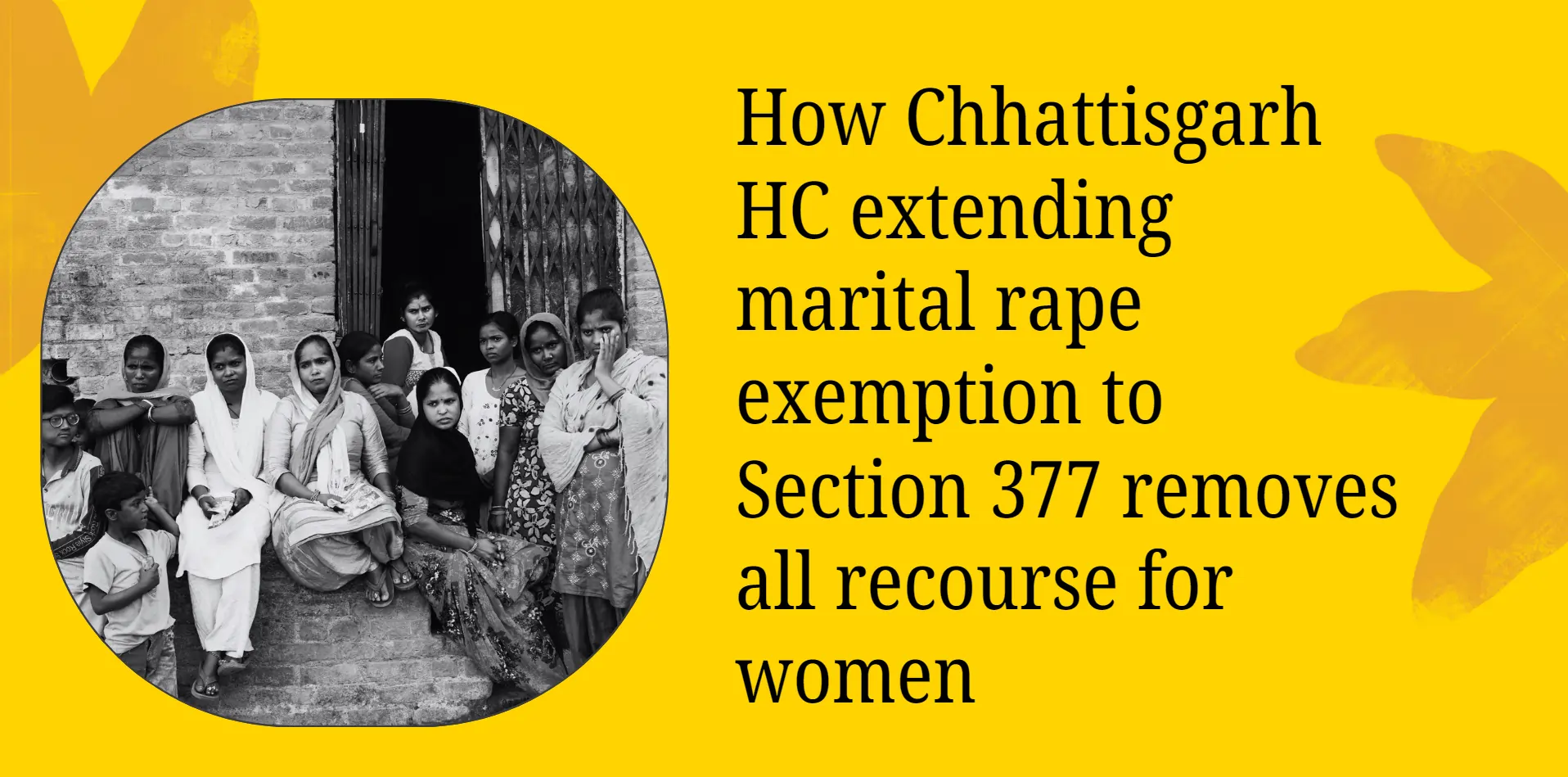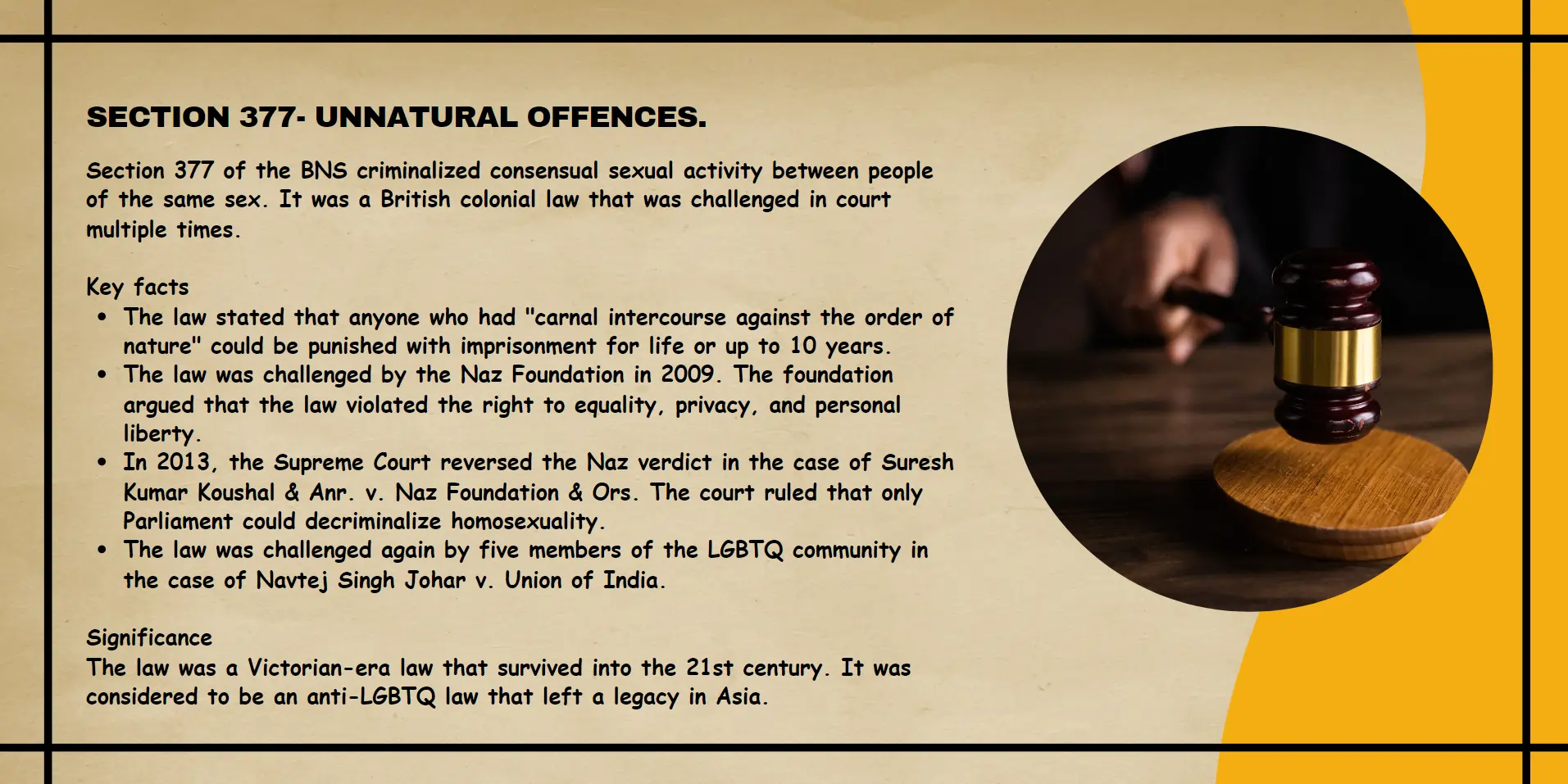
The Chhattisgarh High Court decided to extend marital rape exemptions to Section 377 which led to a contentious discussion about women's rights and legal protections throughout India. By extending this decision to safeguard husbands from prosecution the state questions its dedication to gender equality while denying justice to women. This court decision demonstrates both a reinforcement of negative gender-based prejudices and the loss of vital mechanisms through which victims can seek justice against marital sexual assault.
The judicial decision regarding marital rape interpretation relies on how Section 375 of the BNS defines rape and includes exemptions. According to the legislation a husband cannot be prosecuted for rape against his wife when she surpasses 18 years of age. Section 377 in Indian law defines "unnatural offenses" as actions that include both sexual activities beyond consent. The marital rape exemption approved by the court through Section 377 establishes a judicial backdoor which allows husbands to perform sexual acts against their wives' consent with immunity from criminal prosecution.
The court decision affects women nationwide by weakening their ability to control their bodies as well as their integrity. By permitting this decision the court reinforces traditional patriarchal beliefs about husbands' sexual rights and simultaneously denies married women their basic rights to protect their bodies from abuse.
Many women's rights activists have challenged the legal immunity that exists for marital rape since they claim it sustains gender-based violence while discriminating against women. Through this legal extension the court strengthened the concept that marital consent remains invalid for all sexual advances. Both women's rights representatives and women in general suffered a major blow since the court decision represented a step backward from criminalizing marital rape while denying women basic sexual rights.
Through this legal decision other courts have grounds to maintain the status quo on marital rape being exempt from criminal liability. The judicial decision has established additional barriers through which women face difficulties in gaining protection against sexual violence within their marriages. This judicial ruling creates a public example that non-consensual marital sexual actions are permissible which strengthens damaging sociocultural gender-based beliefs.
The court decision creates a negative effect on sexual violence reporting among women since it creates doubts about both judicial attention to their claims and their eligibility for protective law. Such legal developments would likely damage public trust in legal institutions and make people suspect the state lacks dedication to defending women's rights while delivering rightful justice.
Many individuals now demand legal reforms which would make marital rape illegal together with all types of forced sexual assault. Wilful sexual acts within marriage without consent should be deemed illegal according to arguments made by activists who advocate for women's rights because it breaches women's basic entitlements to equality alongside dignity and bodily autonomy. The civic group demands through their lobbying efforts that government officials should rewrite to eliminate the marital rape exemption. This action aims to establish sexual violence as severe criminal offenses.
What will be the outcomes for women's rights as a result of this judgment?
The decision pronounced by Chhattisgarh High Court creates significant ramifications regarding the rights of women.
- The ruling sustains ancient patriarchal beliefs that permit men to have sexual dominance over their wives while it violates both consent principles and an individual's right to control their body. Such a decision would maintain gender-based discrimination and inequality in both married and non-marital relationships.
- This judicial precedent might ensure further courts will follow which could reduce the possibility of recognizing marital rape as a serious offense through legal reforms. The decision prevents progress toward complete protection against non-consensual sexual acts regardless of a couple being married.
- Due to this decision many women will start to distrust the legal framework that exists to protect them and secure justice. When women avoid reporting sexual violence they encounter in marriage they do so because they lack confidence in legal assistance and protection.
- This decision would strengthen existing social prejudices related to marital sexual violence which would deter women from reporting such incidents. Marital rape victim isolation would increase due to the court decision which maintains a society-wide silence about marital rape events.
- Abused women in marriages now face greater risk of sexual assault because their legal rights have undergone reduction. This judicial decision causes victims and posterity to encounter extended abuse situations because they receive insufficient support when trying to leave abusive relationships.
- The judgment about marital rape has established a major step backward in India's women's rights advocacy movement. Activists have maintained years-long resistance to achieve legal recognition of marital rape as criminal behaviour and they seek complete protection of women's freedom to consent with their bodies. This court decision compromises all previous efforts which now need additional activism combined with legal fights to carry out the necessary reforms.
- An intensified demand for legislative changes to modify the Penal Code by removing marital rape exemptions might arise from this decision. The women's rights movement will campaign for complete law changes to deal with sexual violence in any form without considering marital status.
The effect of Indian women's rights movements has produced changes to Indian legislation.
Indian legislature introduced vital reforms and protective measures to women after major changes occurred through women's rights movements.
Historical Context and Early Reforms
- The Hindu Widow Remarriage Act of 1856 broke social barriers by allowing widows to remarry thus providing them with marital rights after widowhood.
- The Child Marriage Restraint Act of 1929 establishing 14 as the minimum age for female marriage and 18 for male marriage to combat child marriage at its core.
Post-Independence Reforms
- Through critical Acts during the 1955-1956 period known as Hindu Code Bills Hindu women obtained transformative rights in the legal system that extended from marriage to adoption to inheritance and divorce. Women now had complete legal authority to divorce their spouses and gained equal freedom in inheritance and could adopt children.
- The Dowry Prohibition Act of 1961 made efforts to eliminate the custom of dowry since it resulted in dire harassment and physical violence for women. The Act experienced difficulties during enforcement but succeeded in making dowry violence visible to the public.
Modern Legal Protections
- According to the Protection of Women from Domestic Violence Act 2005 women who experience domestic violence can obtain legal protection through the available provisions.
- The Sexual Harassment of Women at Workplace (Prevention, Prohibition and Redressal) Act of 2013 functions to protect female employees from workplace sexual abuse incidents.
- The Maternity Benefit Act of 1961 defines rules for using women workers before and after childbirth to secure maternity benefits.
Institutional Support
- The National Commission for Women (NCW) underwent establishment in 1990 as a statutory organization that manages constitutional and legal protection for women while recommending solutions.
- State Commissions for Women represent the main bodies which focus on regional women's rights concerns across all states.
Challenges and On-going Efforts
These legislative victories encounter obstacles when applying these laws at an effective level. The implementation of women's rights protection suffers due to cultural obstacles together with insufficient knowledge about laws and problems with enforcement procedures. Women's rights movements persistently strive to establish tougher enforcement systems together with wider awareness about women's legal rights.
What The legislation defines marital rape within Indian legal parameters?
The act of spousal sexual violation which occurs between marital couples remains unrecognized while being disputed as a legal matter under Indian law. Solicitation of sexual relations between a husband and wife above age 18 by his own law does not count as rape under Section 375 of the BNS. The legal exemption provides full protection for husbands who perform non-consensual sexual acts with their wives because it lacks criminal status thus creating immunity to prosecution.
Women activists maintain that marriage exemptions function to preserve gender inequality while impeding female control over their bodies. Many women face injustice and bare protection from marital sexual violence because marital rape remains un-legally recognized.
Currently there is increasing support for making marital rape punishable by the law but legal changes remain slow to appear. Modern courts and parliament in India continue their debate about this matter as campaigners push for legal alignment with international human rights conventions. Marital rape exemption currently stands as a core obstacle in achieving gender justice within Indian laws until laws get revised.
Section 377

During British colonial rule Section 377 of the Indian Penal Code emerged as a law which continues to affect numerous Indians throughout the nation. The British government during 1861 passed Section 377 that defined "carnal intercourse against the order of nature" to criminalize homosexual activities among consenting adults. The law functioned as a legal prohibition together with maintaining anti-LGBTQ+ social prejudices. It also led to discrimination against sexual orientation minorities.
British legislation introduced section 377 to the IPC during 1861 by basing it on the Buggery Act of 1533. Section 377 became law because it outlawed sexual acts considered against the natural order of things even though homosexuality and other similar practices were part of its definition at that time. The cryptic language found in the law allowed people to use it in a harmful manner time and again.
Section 377 of the BNS published numerous adverse effects on the LGBTQ+ demographic within the nation. Under this legislation all LGBTQ+ persons became criminals because the law made their existence illegal which resulted in their harassment by abusers and blackmailers and victims of violent attacks. Because of the law many LGBTQ+ individuals experienced the need to hide their identity leading to constant fear through forced silence and concealment. The official ban on-condoned homosexual relationships created an additional burden on LGBTQ+ people while depriving them of fundamental rights to personal dignity.
The constitutionality of Section 377 faced numerous legal attempts at challenge throughout different periods of time. The Naz Foundation case stands as one of the first crucial challenges to combat Section 377. The Delhi High Court made history through its 2009 judgment that decriminalized same-sex adult relationships by applying Section 377 reading down practices. Many people received the court's ruling as a major step toward human rights equality.
However, this victory was short-lived. The Supreme Court of India made a turn in 2013 when it officially restored laws against consenting same-sex love through its ruling on Suresh Kumar Koushal. Large-scale demonstrations along with strong condemnation emerged from both the LGBTQ+ community and their supporters when this decision was announced.
On September 6 of 2018 a historic decision was reached which marked the end of the battle against Section 377. A five-judge Constitution Bench of the Supreme Court delivered the Navtej Singh Johar case to decriminalize every type of sex between consenting adults in 2018. Section 377 became unlawful according to Indian Constitutional rights to equality, dignity and privacy after the court found its application to consensual adult sexual behaviour unconstitutional. This judicial decision marked a historical progress in India regarding LGBTQ+ rights protection.